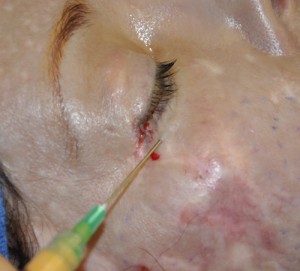Lower eyelid retraction, known as ectropion, occurs for a variety of reasons. The most common reasons are after an elective aesthetic lower blepharoplasty and/or midface lift or after repair of an orbital floor or cheek bone fracture. The lower eyelid retracts downward due to loss of support in one or several of its layers (lamellae) and the pulling effects of scar contracture. Its effects are greatest at the outer corner of the eye and less so medially.
In many milder cases, the lower lid ectropion can be self solving within a few weeks or months after the procedure. More severe cases or those that fail to improve after three to six months require surgical treatment. A variety of lower eyelid ectropion repair procedures exist, most which focus on an eyelid release and either a lateral canthopexy or lateral cantoplasty. While these can be effective, not all work because a portion of the lower eyelid lacks volume and the tissues are stiff and scarred.

The amount of fat needed for each lower eyelid can be as small as 0.5cc up to 2ccs. It is always better to inject as much fat as possible since not all of the fat will survive. When done alone, the diluted fat liquid (nanofat) extract left behind after concentration can be injected directly into the skin using a 30 gauge needle. This adds an additional treatment to the thinner eyelid skin as well.
Dr. Barry Eppley
Indianapolis, Indiana


